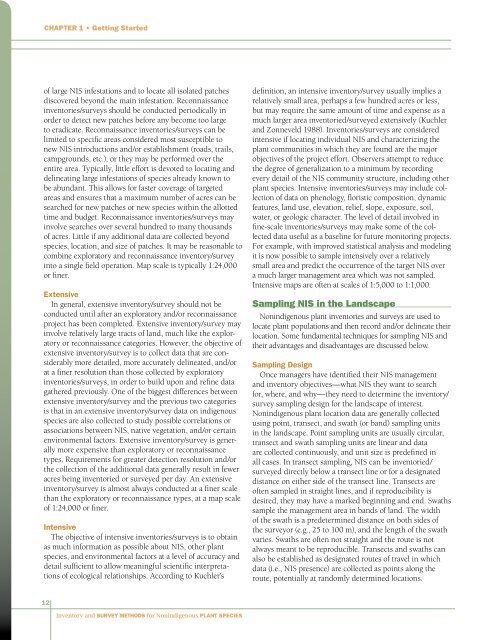Inventory and Survey Methods for Nonindigenous Plant Species (PDF)
Inventory and Survey Methods for Nonindigenous Plant Species (PDF)
Inventory and Survey Methods for Nonindigenous Plant Species (PDF)
- No tags were found...
Create successful ePaper yourself
Turn your PDF publications into a flip-book with our unique Google optimized e-Paper software.
Chapter 1 • Getting Startedof large NIS infestations <strong>and</strong> to locate all isolated patchesdiscovered beyond the main infestation. Reconnaissanceinventories/surveys should be conducted periodically inorder to detect new patches be<strong>for</strong>e any become too largeto eradicate. Reconnaissance inventories/surveys can belimited to specific areas considered most susceptible tonew NIS introductions <strong>and</strong>/or establishment (roads, trails,campgrounds, etc.), or they may be per<strong>for</strong>med over theentire area. Typically, little ef<strong>for</strong>t is devoted to locating <strong>and</strong>delineating large infestations of species already known tobe abundant. This allows <strong>for</strong> faster coverage of targetedareas <strong>and</strong> ensures that a maximum number of acres can besearched <strong>for</strong> new patches or new species within the allottedtime <strong>and</strong> budget. Reconnaissance inventories/surveys mayinvolve searches over several hundred to many thous<strong>and</strong>sof acres. Little if any additional data are collected beyondspecies, location, <strong>and</strong> size of patches. It may be reasonable tocombine exploratory <strong>and</strong> reconnaissance inventory/surveyinto a single field operation. Map scale is typically 1:24,000or finer.ExtensiveIn general, extensive inventory/survey should not beconducted until after an exploratory <strong>and</strong>/or reconnaissanceproject has been completed. Extensive inventory/survey mayinvolve relatively large tracts of l<strong>and</strong>, much like the exploratoryor reconnaissance categories. However, the objective ofextensive inventory/survey is to collect data that are considerablymore detailed, more accurately delineated, <strong>and</strong>/orat a finer resolution than those collected by exploratoryinventories/surveys, in order to build upon <strong>and</strong> refine datagathered previously. One of the biggest differences betweenextensive inventory/survey <strong>and</strong> the previous two categoriesis that in an extensive inventory/survey data on indigenousspecies are also collected to study possible correlations orassociations between NIS, native vegetation, <strong>and</strong>/or certainenvironmental factors. Extensive inventory/survey is generallymore expensive than exploratory or reconnaissancetypes. Requirements <strong>for</strong> greater detection resolution <strong>and</strong>/orthe collection of the additional data generally result in feweracres being inventoried or surveyed per day. An extensiveinventory/survey is almost always conducted at a finer scalethan the exploratory or reconnaissance types, at a map scaleof 1:24,000 or finer.IntensiveThe objective of intensive inventories/surveys is to obtainas much in<strong>for</strong>mation as possible about NIS, other plantspecies, <strong>and</strong> environmental factors at a level of accuracy <strong>and</strong>detail sufficient to allow meaningful scientific interpretationsof ecological relationships. According to Kuchler’sdefinition, an intensive inventory/survey usually implies arelatively small area, perhaps a few hundred acres or less,but may require the same amount of time <strong>and</strong> expense as amuch larger area inventoried/surveyed extensively (Kuchler<strong>and</strong> Zonneveld 1988). Inventories/surveys are consideredintensive if locating individual NIS <strong>and</strong> characterizing theplant communities in which they are found are the majorobjectives of the project ef<strong>for</strong>t. Observers attempt to reducethe degree of generalization to a minimum by recordingevery detail of the NIS community structure, including otherplant species. Intensive inventories/surveys may include collectionof data on phenology, floristic composition, dynamicfeatures, l<strong>and</strong> use, elevation, relief, slope, exposure, soil,water, or geologic character. The level of detail involved infine-scale inventories/surveys may make some of the collecteddata useful as a baseline <strong>for</strong> future monitoring projects.For example, with improved statistical analysis <strong>and</strong> modelingit is now possible to sample intensively over a relativelysmall area <strong>and</strong> predict the occurrence of the target NIS overa much larger management area which was not sampled.Intensive maps are often at scales of 1:5,000 to 1:1,000.Sampling NIS in the L<strong>and</strong>scape<strong>Nonindigenous</strong> plant inventories <strong>and</strong> surveys are used tolocate plant populations <strong>and</strong> then record <strong>and</strong>/or delineate theirlocation. Some fundamental techniques <strong>for</strong> sampling NIS <strong>and</strong>their advantages <strong>and</strong> disadvantages are discussed below.Sampling DesignOnce managers have identified their NIS management<strong>and</strong> inventory objectives—what NIS they want to search<strong>for</strong>, where, <strong>and</strong> why—they need to determine the inventory/survey sampling design <strong>for</strong> the l<strong>and</strong>scape of interest.<strong>Nonindigenous</strong> plant location data are generally collectedusing point, transect, <strong>and</strong> swath (or b<strong>and</strong>) sampling unitsin the l<strong>and</strong>scape. Point sampling units are usually circular,transect <strong>and</strong> swath sampling units are linear <strong>and</strong> dataare collected continuously, <strong>and</strong> unit size is predefined inall cases. In transect sampling, NIS can be inventoried/surveyed directly below a transect line or <strong>for</strong> a designateddistance on either side of the transect line. Transects areoften sampled in straight lines, <strong>and</strong> if reproducibility isdesired, they may have a marked beginning <strong>and</strong> end. Swathssample the management area in b<strong>and</strong>s of l<strong>and</strong>. The widthof the swath is a predetermined distance on both sides ofthe surveyor (e.g., 25 to 100 m), <strong>and</strong> the length of the swathvaries. Swaths are often not straight <strong>and</strong> the route is notalways meant to be reproducible. Transects <strong>and</strong> swaths canalso be established as designated routes of travel in whichdata (i.e., NIS presence) are collected as points along theroute, potentially at r<strong>and</strong>omly determined locations.12<strong>Inventory</strong> <strong>and</strong> <strong>Survey</strong> <strong>Methods</strong> <strong>for</strong> <strong>Nonindigenous</strong> <strong>Plant</strong> <strong>Species</strong>
















